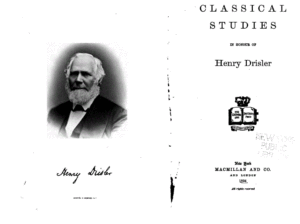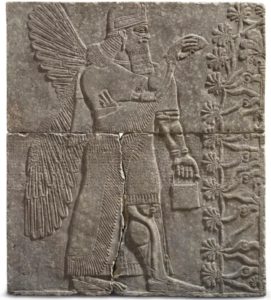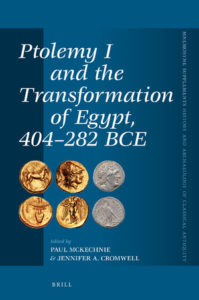The study I have co-authored with Alexis Belis on the Urartian belt in the J. Paul Getty Museum and its relevance for the history of the ‘Parthian shot’ — both as a motif and as a military tactic — has been accepted for publication in the Getty Research Journal 12 (to be published in 2020). We are now finalizing the text and figures.
Upcoming lecture at UC Irvine
On March 11 I will be presenting at the second Payravi Conference on Ancient Iranian History at the University of California, Irvine’s Jordan Center for Persian Studies. The theme of the conference is “The Persian-Achaemenid Empire as a ‘World-System’: New Approaches & Contexts,” and my talk addresses the Achaemenid Empire and Africa. It will include discussion of tribute, diplomacy, ideology and the Red Sea canal, though I am still working out the details.
As I have noted here before I am moving away from the study of Egypt; accordingly, I expect this presentation, and any publication that may result from it, to be my last remarks on the subject for some time. That said, I have no idea where my career will take me next, and it is entirely possible that I will find it expedient or worthwhile to return to Egypt at some point. But now that my book is in press I am running out of things to say about it, while the allure of the Iranian Iron Age only grows stronger (I love a good beaked pitcher).
The first Festschrift?
In an editorial commemorating the first twenty volumes of the State Archives of Assyria Bulletin (vol. 20 [2013-14], pp. 1-31), the great Assyriologist Frederick Mario Fales observed (p. 6 n. 11) that the earliest Festschrift of which he was aware with content relevant to the field of Near Eastern studies is Orientalische Studien Theodor Nöldeke zum siebzigsten Geburtstag (2. März 1906) gewidmet von Freunden und Schülern und in ihrem Auftrag, edited by Carl Bezold (Gieszen: Verlag von Alfred Töpelmann, 1906).

Quite by chance I have come across an older example, from the United States in fact: Classical Studies in Honour of Henry Drisler (New York: Macmillan and Co., 1894). Although focused primarily on Greek and Latin, it also contains essays such as “References to Zoroaster in Syriac and Arabic Literature” by Richard J. H. Gottheil and “Herodotus vii. 61, or Ancient Persian Armour” by A. V. Williams Jackson.
This discovery has prompted me to be on the lookout for earlier examples, which I will post here as I encounter them. This project serves no scholarly purpose whatsoever, save to satisfy my own curiosity.
Incidentally, Fales’ entire editorial is very much worth reading (as is all of his scholarship) for its insights on how the field of Near Eastern studies has changed since 1987.
More on the events at the SCS
I’d like to draw attention to some written responses to the events of this past SCS, by Dan-el Padilla Peralta himself, Joseph Crawley Quinn, and the blog Medievalists of Color, all of whom have more intelligent things to say than I do. Needless to say, I’m not optimistic about the future of the field of Classics; actually, I think it’s long past time that it went away altogether, and that classicists had to account for themselves in departments of history, Romance languages, Near Eastern studies, etc. Until that happens I don’t expect we’ll move the needle any.
The World between Empires: Art and Identity in the Ancient Middle East
This morning the Agade mailing list delivered to my inbox the press release for the upcoming exhibition at the Met The World between Empires: Art and Identity in the Ancient Middle East, which opens March 18. The exhibition is curated by Michael Seymour and Blair Fowlkes-Childs (with whom I share an office). To wet your whistle, here’s the signature image for the exhibition:

I am excited by this exhibition for three major reasons (among a host of minor ones). First, it focuses on the material culture of the Near East (especially Mesopotamia and Levant) in the late first millennium BCE and early first millennium CE. This is not a period that gets much attention, in museums or in scholarly circles. For Near Eastern scholars this is when cuneiform finally dies out, and for Classicists it is mainly of geopolitical interest, specifically in reference to Rome’s wars with the Parthians and Sasanians or Silk Road trade. And the last time the Met gave much attention to this period was in 2000 as part of the exhibition The Year One: Art of the Ancient World East and West.
Second, the exhibition focuses on the agency of the people living in the Levant and Mesopotamia in this period, by examining how they constructed their various identities through art and material culture. Rather than thinking about them in terms of ‘Romanization’ (or its Persian equivalent, whatever that may be), it takes a local approach, considering each region on its own terms. In this respect it is very much of a piece with modern archaeological studies of borderlands, such as those pioneered by the late Bradley Parker.
Third, it explicitly addresses how current geopolitics have affected these regions. I am less familiar with this aspect of the exhibition, but I am looking forward to learning more about it when it opens in March!
Upcoming Met Perspectives talk about the Christie’s sale of an Assyrian relief

Next Friday (January 18) I will be giving a brief Met Perspectives gallery talk about Christie’s record-setting auction last October of a Neo-Assyrian relief, formerly at the Virginia Theological Seminary. It is part of a series of three gallery talks on ‘Art and Trade,’ and will take place at 6:00 in Gallery 401.
But wait, there’s more
My own reasons for disliking the AIA pale in comparison to what actually happened this year.
As I have said before, and no doubt shall say again, Classics is a fundamentally racist field, and whatever value it has was acquired and maintained at the expense of others. And I don’t expect that to change anytime soon.
Why I’m not going to the AIA meeting
The annual meeting of the Archaeological Institute of America starts today in San Diego, and I am pleased to say that I won’t be there. Unlike last year, when my absence was the result of inclement weather in Boston, this year I am not attending by choice — a luxury afforded by my two-year fellowship at the Met. I would have stopped attending long ago if I had any choice in the matter, which I feel I do not, so long as I am actively looking for employment as an archaeologist in some capacity. Thus this seems like an opportune moment to articulate why I don’t care for the AIA meeting, if only for cathartic reasons.
- It’s expensive. My first job included travel funds, which was nice, but my next three did not, meaning that whatever I spent came out of my meager salary. This year Jacquelyn Clements has created an informal survey to try to get a sense of how much one typically spends going to the meeting, and I am looking forward to seeing the results.
- The talks are terrible. Certainly there are exceptions to this; in Seattle in 2013 I saw a brilliant talk on how timekeeping is a social construct and what its implications are for archaeology in Armenia. However, it followed a talk arguing that no one in the Near East knew how to swim. The bar is much too low.
- There are too many talks. Even if I am fortunate enough to find a handful of talks that interest me, they are invariably scheduled at the same time in widely disparate places. The meeting would be greatly improved if there were far fewer parallel sessions, and therefore far fewer talks, meaning that the standard for acceptance would have to be raised (in theory, anyway).
- The talks are too heavily slanted towards reports on fieldwork. That is not to say such reports are unimportant, but as often as not these reports are a tedious list of trenches dugs and objects recovered, without any attempt to engage with the broader research question. As a result, the talks are only meaningful to people already intimately familiar with the site or region in question – very inside baseball (and very dull). Perhaps the broader problem is that most of the archaeologists giving these talks do not have research questions any more complex than “what will I find if I dig here?” or “will I find the same things as I did last year if I keep digging in the same place?”
- Roman archaeology dominates the meeting. Perhaps this is simply a reflection of the preponderance of Roman archaeologists in the field of classical archaeology, but this causes the meeting to be even less inclusive and interesting. The presence of a token panel called ‘The Near East’ is one of the clearest examples of the chauvinism of the classics. Just because the Greeks hated the Persians doesn’t mean that we should too.
- There are no meaningful networking opportunities. Faculty in graduate programs like to toss out the old canard that the meeting is good for ‘networking’ (this is what passes for ‘advice’). Anyone who has been to the meeting knows this is not true. The key to networking is to have senior faculty at one’s own institution introduce students and early career scholars to their senior colleagues. But those senior faculty, if they attend the meeting at all, spend the entire weekend drinking with their senior colleagues, to the exclusion of lesser beings such as students and recent graduates. Moreover, this generally takes place in the prohibitively expensive hotel bar.
- Candidates interviewing for jobs generally cannot relax until the last of their interviews has taken place. Candidates with no interviews generally cannot relax at all. This makes it hard to care about how many sherds of terra sigillata were recovered from Trench C33.16NE.
- It is true that I will miss seeing old friends, but by now, after five years on the market, most of my friends either have jobs or have stopped looking, and therefore have no need or desire to attend the meeting.
Here concludes the rant. If you’re interviewing for a job in San Diego, good luck!
My book manuscript is submitted!
Happy New Year! I am very pleased to report that I have just submitted the full manuscript of my book Archaeology of Empire in Achaemenid Empire to the Edinburgh University Press. If all goes well it will appear in the series Edinburgh Studies in Ancient Persia, but of course further rounds of revision may be necessary before that happens! I shall provide further updates here as events warrant.
Review of Ptolemy I and the Transformation of Egypt, 404-282 BCE
 Tara Sewell-Lasater of the University of Houston has just reviewed Ptolemy I and the Transformation of Egypt, 404-282 BCE in the Bryn Mawr Classical Review. I am pleased to report that she saw my chapter, “The Role of Coinage in the Political Economy of Fourth Century Egypt,” in a very favorable light, and I am especially gratified that she appreciated my efforts to integrate coins into the study of the ancient Egyptian economy.
Tara Sewell-Lasater of the University of Houston has just reviewed Ptolemy I and the Transformation of Egypt, 404-282 BCE in the Bryn Mawr Classical Review. I am pleased to report that she saw my chapter, “The Role of Coinage in the Political Economy of Fourth Century Egypt,” in a very favorable light, and I am especially gratified that she appreciated my efforts to integrate coins into the study of the ancient Egyptian economy.
This chapter grew out of my 2011 paper for the American Numismatic Society’s Eric P. Newman Summer Seminar. Part of it, focusing on the fifth century BCE, will appear in a my forthcoming book Archaeology of Empire in Achaemenid Egypt. But in trying to understand the role of (Greek) coins in Persian period Egypt I found myself trying to understand the structure of the Egyptian economy, and the paper accordingly ballooned into this chapter! The fourth century, which really falls outside of the parameters of my book, was the perfect place to try to test these ideas.
As I have often said in person, I am not an Egyptologist and I have no ambition to become one. Nor am I especially skilled as a numismatist, though I continue to develop my abilities in that area. So this chapter will probably be my only foray into Egyptian history and archaeology outside of the context of Achaemenid rule. I am happy that it has been well received so far!
Incidentally, I have also published a very brief discussion of this same topic on pages 113-15 of Beyond the Nile: Egypt and the Classical World, the catalog accompanying the eponymous exhibition at the J. Paul Getty Museum (which closed September 9).
